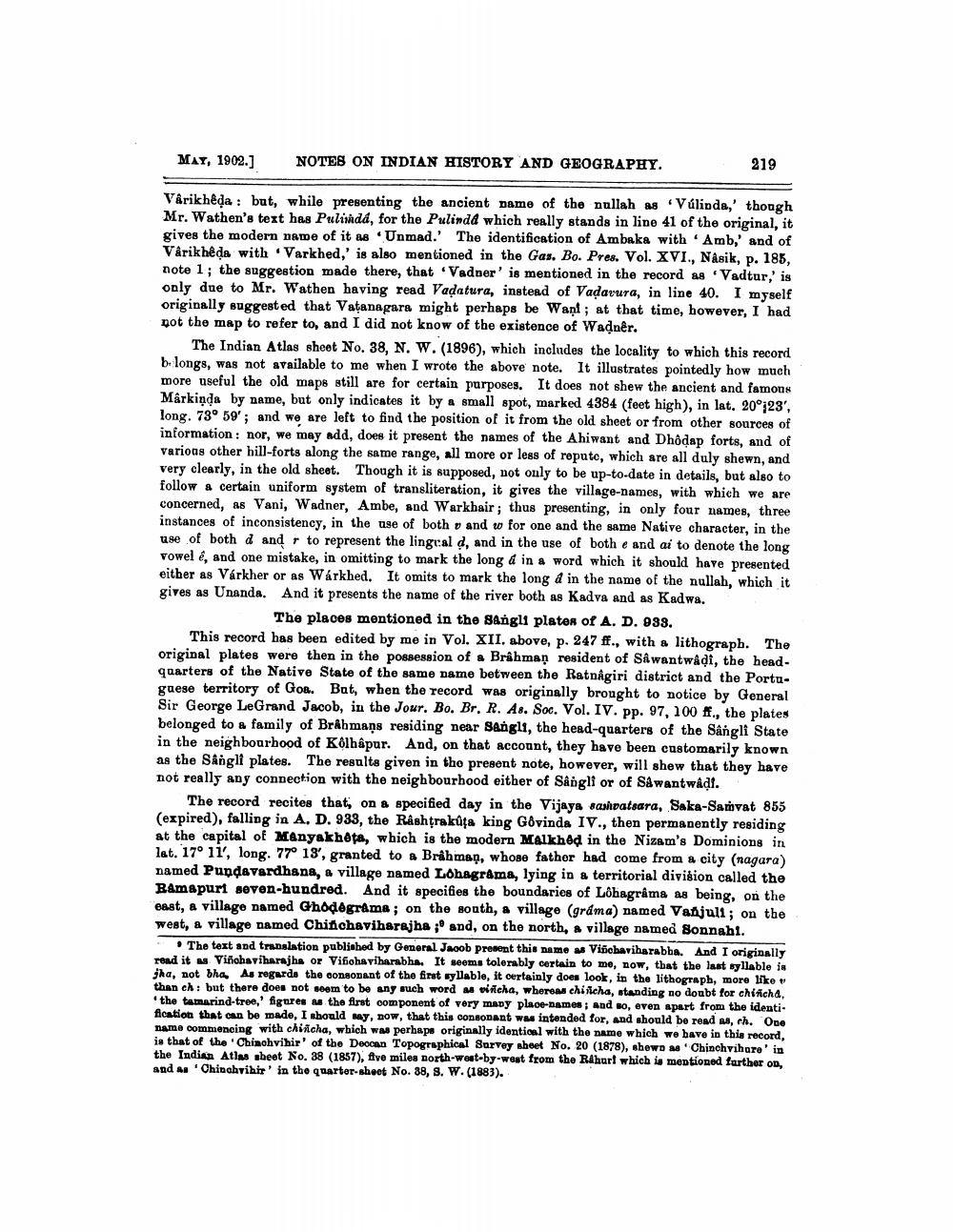________________
MAY, 1902.]
NOTES ON INDIAN HISTORY AND GEOGRAPHY.
219
Varikhêda : but, while presenting the ancient name of the nnllah as Vúlinda,' though Mr. Wathen's text has Pulida, for the Pulindd which really stands in line 41 of the original, it gives the modern name of it as Unmad.' The identification of Ambaka with Amb,' and of Vârikheda with Varkhed,' is also mentioned in the Gas. Bo. Pres. Vol. XVI., Nasik, p. 185, note 1; the suggestion made there, that "Vadner' is mentioned in the record as 'Vadtur,' is only due to Mr. Wathen having read Vadatura, instead of Vadavura, in line 40. I myself originally suggested that Vatanagara might perhaps be Want; at that time, however, I had not the map to refer to, and I did not know of the existence of Wadnêr.
The Indian Atlas sheet No. 38, N. W. (1896), which includes the locality to which this record b-longs, was not available to me when I wrote the above note. It illustrates pointedly how much more useful the old maps still are for certain purposes. It does not shew the ancient and famous Markiņda by name, but only indicates it by a small spot, marked 4384 (feet high), in lat. 20° 23', long. 73° 59'; and we are left to find the position of it from the old sheet or from other sources of information: nor, we may add, does it present the names of the Ahiwant and Dhôdap forts, and of various other hill-forts along the same range, all more or less of reputo, which are all duly shewn, and very clearly, in the old sheet. Though it is supposed, not only to be up-to-date in details, but also to follow a certain uniform system of transliteration, it gives the village-names, with which we are concerned, as Vani, Wadner, Ambe, and Warkhair; thus presenting, in only four names, three instances of inconsistency, in the use of both and w for one and the same Native character, in the use of both d and r to represent the lingcald, and in the use of both e and ai to denote the long vowel é, and one mistake, in omitting to mark the long & in a word which it should have presented either as Várkher or as Wárkhed. It omits to mark the long d in the name of the nullah, which it gives as Unanda. And it presents the name of the river both as Kadva and as Kadwa.
The places montioned in the Sangli platon of A. D. 038. This record has been edited by me in Vol. XII. above, p. 247 ff., with a lithograph. The original plates were then in the possession of a Brahman resident of Sawantwadi, the headquarters of the Native State of the same name between the Ratnagiri district and the Portuguese territory of Goa. But, when the record was originally brought to notice by General Sir George LeGrand Jacob, in the Jour. Bo. Br. R. As. Soc. Vol. IV. pp. 97, 100 f., the plates belonged to a family of Brahmaņs residing near Sangli, the head-quarters of the Sângli State in the neighbourhood of Kolhapur. And, on that account, they have been customarily known as the Sangli plates. The results given in the present note, however, will shew that they have not really any connection with the neighbourhood either of Sangli or of Sawantwadi.
The record recites that, on & specified day in the Vijaya sashpatsara, Saka-Samvat 855 (expired), falling in A, D. 933, the Rashtrakůța king Govinda IV., then permanently residing at the capital of Manyakheta, which is the modern Malkhed in the Nizam's Dominions in lat. 17° 11', long. 77° 13', granted to a Brahman, whose father had come from a city (nagara) named Pundevardhana, a village named Lohagrama, lying in a territorial division called the Bamspurt seven-hundred. And it specifies the boundaries of Lôhagrama as being, on the east, a village named Ghodégrama; on the south, a village (gráma) named Vanjull; on the west, a village named Chinchavihsrajha ;' and, on the north, a village named Sonnabi.
The text and translation published by General Jaoob present this name - Viñobaviharabba. And I originally read it as Vinohaviharajhs or Vifioha viharabha. It seems tolerably certain to me, now, that the last syllable is jha, not bha As regards the consonant of the first syllable, it certainly does look, in the lithograph, more like then ch: but there does not seem to be any such word as vincha, whereas chifcha, standing no doubt for chificha, the tamarind-tree,' figures as the first component of very many place-Dames; And so, even apart from the identification that can be made, I should my, now, that this consonant was intended for, and should be read wch. One name commencing with chincha, which was perhape originally identical with the name which we have in this record, is that of the Chinohvihir' of the Deocan Topographical Survey sheet No. 20 (1878), shewn as Chinchvihore' in the Indian Atlas abeet No. 38 (1857), flye miles north-west-by-west from the Rahurt which is mentioned further on, and en Chinchyihir' in the quarter-sheet No. 38, S. W. (1883).




